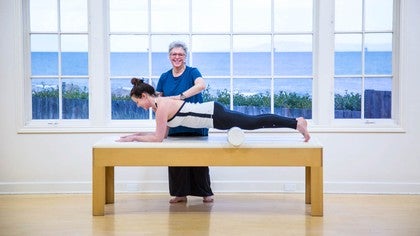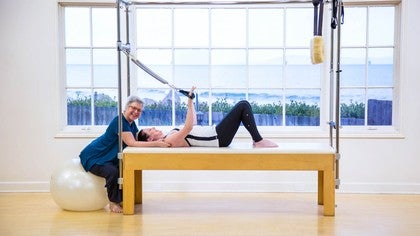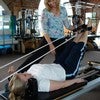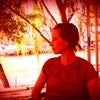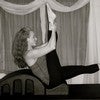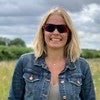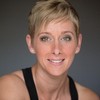Description
About This Video
Transcript
Read Full Transcript
So we're going to talk about the rotator cuff muscles and a lot of what we know in our training is doing this movement. And it's a great exercise in, especially if you have a client that is in trauma. It's a great exercise to start with, but the humor, the rotator cuff muscles are responsible for keeping that bone in the socket. So as I go out to the side, the humorous bone slides into the center and as my arm goes up, it slides down. As I bring the arm bone forward, that humeral head should slide backwards.
And as I bring the arm back in space, it should slide forward. So what happens is the rotator cuff muscles are all around the shoulder blade and their attachment is only in the shoulder blade. It has no attachments to the ribs, it's their main job is keeping that bone center. So we're going to look on Aaron, how these muscles are going to help her phrasing of her arm. So Aaron, come on over here and I'm gonna add, the one thing I'm going to be teaching is this wonderful work that I've been working with Irene Dowd and it really teaches you how the rotator cuff is moving when I'm going through a full range of motion. And that's, it's doing different things, but it's really what we need to learn in our practice.
Now Aaron, I want you to bring your arm up and I want you to rotate your humeral head outwards. So you're just going, that's inward, that's outward. And then I want you to take your hand. And I want, she's has her shoulder blade in upward rotation. So if we had her face side there, it's an upper rotation. Then she's gonna bend her arm and you can do this with us. You, she's going to put her hand in front of the elbow. She's going to energetically think of bringing the humeral head lightly back at the same time. She's moving the tip of the shoulder blade forward.
So it's all about let's have you walk a little more forward so that she tends to retrack that shoulder blade. And we want her to think this is reaching that way. Now I'm going to hold her shoulder blade. You could do this yourself. She's gonna let go of this arm. And I want her just to play with how much could she move that arm without the shoulder blade.
So there are certain movements we need to be moving the humorous bone. And then if we do an external and internal rotation, that's how we need to find that. Cause a lot of times what you see is people are moving faster with the shoulder blade. And it's really where the humorous bone is in space. So now if Aaron faces this way, and if you were to do this in your own practice, you put your hand underneath. Remember we're gonna be this light with our practice.
She just lightly presses down and she, and if we also go, she could even feel, I'm going to press that. You're going to, I'm going to be your head and she's going to put her hand right here underneath her armpit. So the subscapularis comes underneath the shoulder blade and I'll show in a second. And what she's gonna do. She's going to externally rotate and she's going to internally rotate all the way down. This is what we do all day long, pulling on springs and there we go. This, this is the baseball player throwing the ball. Okay, so the subscapularis comes.
So this is turn around for me please. So this is the post here, part of the Scapula. The subscapularis comes on the anterior part of the shoulder blade. Again, the attachments are only within the shoulder blade and then it comes across. So if I could put my hand in here and it attaches to the humerus bone, again, you can feel it. If you go, you almost have to go a little underneath your armpit and you think you're about to go back. You can feel it working. Okay, that's great. Okay, great.
So let's have her turn around and I don't look at the difference between this shoulder blade, the one she just worked and this shoulder blade. Okay, I'm just going to review one more time because it takes a while to understand it. Aaron's gonna lift her arm up and we want her arm to be in upward rotation. So if she was to put her right hand, her goal right here is to feel that shoulder blade wrapping and shaping around the curves of her ribs. Then she's going to bring her elbow down and now she's going to put her hand lightly on her elbow.
She's going to lightly bring that humeral head in. She's starting to pull her armpit down. So it's, it's kind of like sucking the bone light light, like like a cold milkshake. And then at the same time she wants to get that shoulder blade rapid. We want that shoulder blade very quiet. And now she has a little pressure down my hands at her armpit.
I can feel a little bit of tone. Remember it's very light. She's going to do external rotation and she's gonna do internal rotation all the way down. Go down, go down and extra internal rotation. Great. And the purpose in your practice is not to move the shoulder blade, so you're going to discover she started to move her shoulder blade. Sometimes when there's tightness in the rotator cuff muscles, you try to do it with your shoulder blade. What's great about this exercise is it's starting to train the muscles in in different ranges of motion and it can help open the shoulder blade and the shoulder girl come to stand in front, let everything go.
Oh lovely. So we're going to go to another rotator cuff muscle. And one thing I want you to think about the rotator cuff muscle. It's like having a circus tent and you have many wires that are helping support the shoulder blade and the scapula. But if I put the Scapula in the row and let's say downward rotation, I change the 10 secretary of the rotator cuff muscles.
So it's really important that we get this shoulder blade in. I will say neutral. And that means shaping around the design of your ribs. You're going to start inviting the right phrasing. Now the superspinatus, this is called the superspinatus Faso or some books say notch. And it comes through here and it grabs on to the uh, humorous bone.
You're going to hold the humorous bone and it says if my finger is a puppet string and that superspinatus is gonna slide short to pull it up and it's still working as it slides down to control that humeral head down. Now we're going to do it one more time. The superspinatus go head is kicking it about 10 degrees. Then it also is having a little bit of Deltoids, but what I always want you to think about is we have to have a wide clavicle and a wide shoulder blade, so we're going to have Aaron turn around and I am going to place my hand here to give that so she wants to pull back and we want to get that with. She's also going to do a certain rotation of the humerus bone, which also going to get the right phrasing when she this more right now my hand is di drawing around the shape of her, her right shoulder blade.
This is called scaption so that when she starts lifting the arm up, I want it in line with the shoulder blade. And then as she goes up, it's going to go a little forward. So the shoulder blade is wide, the clavicles wide, she's going to go back down, go back. So your internally rotated your hand. You go to gradually open your arm out to the side, out to the side, keep going. And now she's gonna rotate outward hold. Be a little more energetic through your fingers.
Then go diagonally forward and lift the arm up. There we go. That's all I want. That's all I want. And then she's going to bring the arm back down and she's going to run the film backwards. So she's going to gradually go back. What? She's going to keep that clavicle up and touch your head, your waist, hip, I'm sorry. And now do that again. So there's that little puppet string, lifting her up, she's going to externally rotate and then she's going to go up.
Great. Now she's going to turn around so you can see the front. And when I do this, I'm always thinking about the width and there's even in my practice, I want to start here and I'm going to go, oh Leslie, I can feel I'm doing this. I'm going to stop. I'm going to keep going wider and wider cause there's no reason for the shoulder this to get active. We're just trying to wake up through here. So again, this is her harder side that we're trying to get that shoulder blade to live a little more shaping around the ribs and she, her hand is facing towards her hips and as she reaches her arms out to the side hold, be a little more energetic through your fingertips. Think this scapula reaches to the elbow, the elbow to the fingertips. Then you're going to get that why clavicle and that's all I want right now.
And then you're going to bring the whole thing back down and through. Now we're going to talk it starting to, Oh that looks good. We want to think about the tip of the shoulder blade reaching to the little pinky and the the clavicle reaching to the thumb. So I want her to really spread her wings. So she's gonna open out to the side hold. I feel this retracting in.
So I want her to visualize more with keep going. There we go. Then you're going to lightly turn that humeral head in the socket. Great. Her shoulder blade girdle. Is it a fabulous place? She's going to slowly let the puppet string bring the humorous bone down and it's just sliding in the socket and you don't have to do anything about pressing the shoulders down and then let it go. And let's look at that. That looks good. Okay, now we want to look at the back and you can see she's starting to get a little bit more with. So it's, it's kind of like having a shirt on a hanger. If it, if the, the sh the spine in the shoulder blade is not sitting right, the clothes don't hang well as we wake up the rotator cuff muscles, it's gonna pull the humeral head lightly back and that's going to give you that shoulder blade dropping. It's kind of like a, a oxymoron because sometimes this is where we're living and we keep pressing down and down and it's just slowly waking up.
The phrasing around the shoulder girdle is going to bring in better mechanics. So we're going to look at one more time, uh, doing the shoulder blades a at first when I'm teaching this, I'll do one arm at a time and then it, you'll see when I teach the reformer class, I'll bring it right into two arms. But this is like a really hard concept for your clients to understand. So she's got, we're going to bring that humeral head lightly back. Her arm is in, uh, facing.
It's a little bit internal rotation. She's gonna get that scap a little wide and stay. There you go. She's going to think why clavicle my hands like a Japanese fan that's going this way. And then here it's just a light rotation. Look at that shoulder blade. It's fabulous.
I'm going to just hold her clavicle up. Her shoulder blade girdle is in a great place. Can She just bring her arm down? It's gonna spin lightly in that socket. Not too fast. There we go. And there we go. Great.
And we're going to look at the other side and here she goes. Okay. There we go. Go directly the side, reach through your fingertips. There we go. Wide shoulder blade as she comes a little higher and you want to have it a little more in front and there you go. And then you're going to bring the whole thing down. Our clients are going to have more success of the arms being in front of them.
Eventually I do want them to get back, but I'm always, until I get that rhythm, I'm going to have them more into the front of them. Nice back. Um, next we're going to go to the posterior cuff muscles. So if we look at the back of the Scapula, you can sit. We'll get here soon. Is now, um, you have your infraspinatus, your Terry's miner coming through here. And sometimes there's a Terese major down there as well.
I kind of call it like opening a door. Is that, can I open the door and the, this fasa is the hinge and I want to see how far I can move that arm without moving the shoulder blade. So she turns around again and we look at, so the here is the medial part of the shoulder blade. Here's the infraspinatus Teri minor. It grabs onto the humeral head here. So we want to get her arm.
So it's kind of like there's the movement right there. So we're just trying to get it to happen at the joint and that shoulder blades should stay wide. And remember we started to, if we brought her arm up again, I'm going to get her a little bit better upward rotation and then I'm going to bring her arm back. And she did great. She didn't, she kept her shoulder blade wide. So if she brought her arm across and I'm going to give a load. So my hand is here and it's as if she's opening a door with her arm. So she's, and she's going to lightly, oh, push me out and we want to keep going, but I don't want her to come up, press, press, press, press.
And I'm seeing where my finger is. That's where the movement should be happening. She's going to still stay pressing on me and bring it back. Press slightly against me. Okay, that's a little heavy. And then go, go, go and then open out. Yup. Shoulder blade stays wide. Keep going, keep going, keep going, keep going.
Sometimes if I have a client with a shirt on, they have the seam of their shirt. It's a great idea of, of saying you're moving from there. If we look at or forward, turn around, well let's do a profile. So here she is, let's bring her arm up against. So she gets that shoulder blade, uh, around her, uh, ribs. Bring your arm down. So the load is here. So she's opening the door and she's lightly pressing back on me without ad ducting, the shoulder blade, she's going to keep load.
So it's like not letting the door slam. Don't slam door and bring the arm across. More and more and more. She wants to pull her armpit down and I want her to Ope, I'm the door, not this is the door feel where I'm tapping. She's going to open her arm out. I'm going to tap. Tapping is a great way to get your client to think of where to move and then bring the whole thing back. And there we go. Great.
Now what's hard about this exercise? Uh, bring your arm across like this is when I come across and I press out. I'm ecentric sickly loading the rotator posterior rotator cuff and she can't go as far, but she's gonna use her hand to be the load. Then I'm concentrically training it and then I have to keep pressure against it even though I'm bringing it in. And that's kind of the phrasing we want to start to get in that dance of the rotator cuff muscles around the shoulder blade. Let's see her, uh, come down. Let's just have your arms come down and let's see what's happened there. Oh, that looks good. Face backwards too. There you go.
We're still going to work on this. She's still having some problems there, but his, she's getting wider, uh, because we're getting a better sense of that humeral relationship to the shoulder blade. Okay. So now we're gonna Start Teaching, uh, this wonderful a phrase that we started learning in my class with Irene doubt. I'm teaching this to all my clients. They can do this anywhere. This is their homework. And again, I K I want to keep saying it's this much effort, but it's really wonderful to be teaching this because a lot of your clients are having rotator cuff, muscle problems or tears and they need to be woken up. So I'm going to teach a series a using a wall.
And this is something that I'm teaching my clients. It's from my teacher, Irene doubt. It's a, it's abbreviated form of it. Um, and the first one we're going to do is of using the subscapularis. So she, Aaron's going to face towards the wall and she's going to go into external rotation. Again, remember it's this light as she, she's going to slowly draw her arm and gradually internally rotate and go add duck meaning towards midline. And then she's going to gradually go out and externally rotate. Again, she's doing a great job. There's, you only want to get, and she still needs to go across a little bit down, like you're pulling money out of your pocket and then you're throwing confetti over your shoulder. There you go. There you go. Okay. And then let's look at the other arm. Come this way and same idea and here's that shoulder blade wide.
So she, she, you're great. And now you're going to gradually rotate. And I want her to think she's about to pull money out or confetti out of her pocket. And we want her to rotate but not pour armpit down. So remember, it's all about how we're rotating the humorous bone in that shoulder socket with pretty much the shoulder blade staying very quiet. So the next exercise we're gonna do against the wall is for the superspinatus.
So Aaron's gonna face profile to the wall and she's going to praise her palm, the back of her hand against the wall. What you need to do is you need to walk away whatever your arm length and remember again this much pressure. So she's going to walk away a couple inches and the arm comes a little bit of forward. As she goes up. She still keeps going towards me and then she wants to externally rotate that arm and then she's going to come back in and she's going to gradually face the palm down against the wall. So there we go and she's going to do that out.
And this is hard for her stay. She doesn't, she wants to use her shoulder and that's all I'm going to go in height with her and then bring it back down and there we go. Let's do the other side. So again, remember your palm is facing that way. She's going to gradually push away the arm starts going in front of her hip and then she's going to gradually rotate her humorous bones stay. She's going to visualize her clavicle right here is floating up like with a balloon and then she's going to gradually go back. So I'm not letting her depress her shoulder blade down.
I just want to get that superspinatus, which comes right here. If you think of your seam on your shirt, it's the perfect law line of the superspinatus. There we go. She's going to go up. There we go. And then she's going to gradually go back down and press the, and she's just has a light pressure against the wall. So now we're gonna look at the posterior cuff muscles and how to train it.
So Aaron's going to bring the arm across. The palm is facing towards a wall. So that's internal rotation. And it says, remember the door image? It's like gently pushing the door open and you have to walk away to give the right, she needs a walk away, walk away, walk away. So that she has space in that a shoulder girdle.
And then she's gonna walk back. She's gonna gradually, she internally rotate and she might even turn a little bit too. It puts it on the stretch as well as she's pushing against it. So it's essentially training. Walk, walk away, walk away, walk away. There you go. So what's happening is a, what I want Aaron to do a little bit more is she's still, she's doing more turning and she needs a walk away to give her shoulder girdle room. So let's, uh, let's do that one more time and go and so your arms should be straight and a little lower down. Okay, let's do that. Let's do the other side. So here it is, that shoulder blade is wide.
She could even turn a little bit to it to get a little more stretch. She's lightly pressing and she's going to walk away and you're going to come to me and there we go. There we go. And then that puts it on the stretch and it's activated. If she had a sleeve, it's right there. Walk towards it. There you go. She might lean but she keeps that shoulder blade wide and then she walks away. Remember your arm is pretty straight and we just want to get this working back here. That's supposed to your cuff muscles. Now we're, we've been talking a lot about getting this shoulder blade wrapped and that it has the influence of the anterior serratus. So that will be our next tutorial.
Embodied Anatomy: Upper Body
Comments
You need to be a subscriber to post a comment.
Please Log In or Create an Account to start your free trial.

